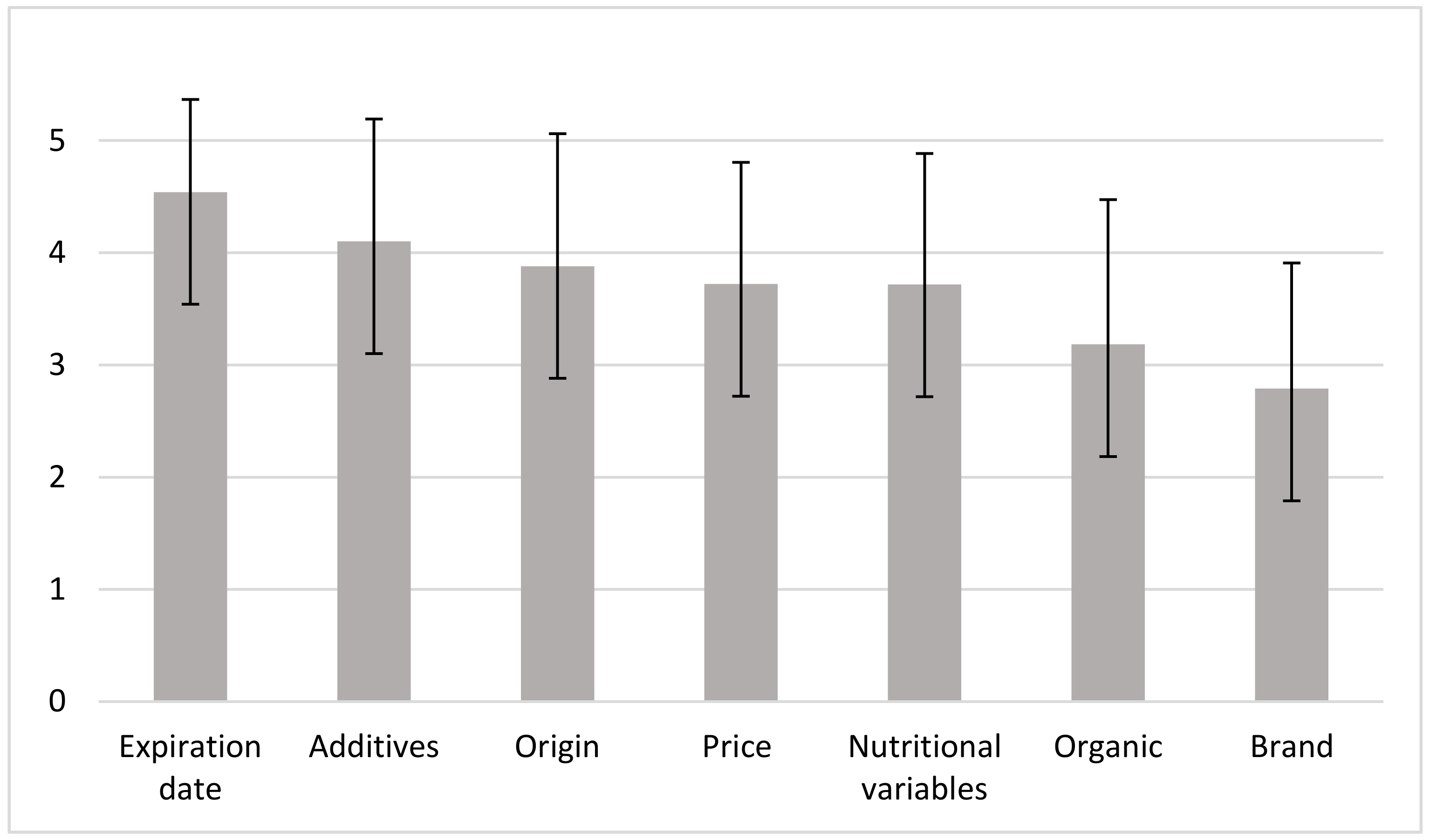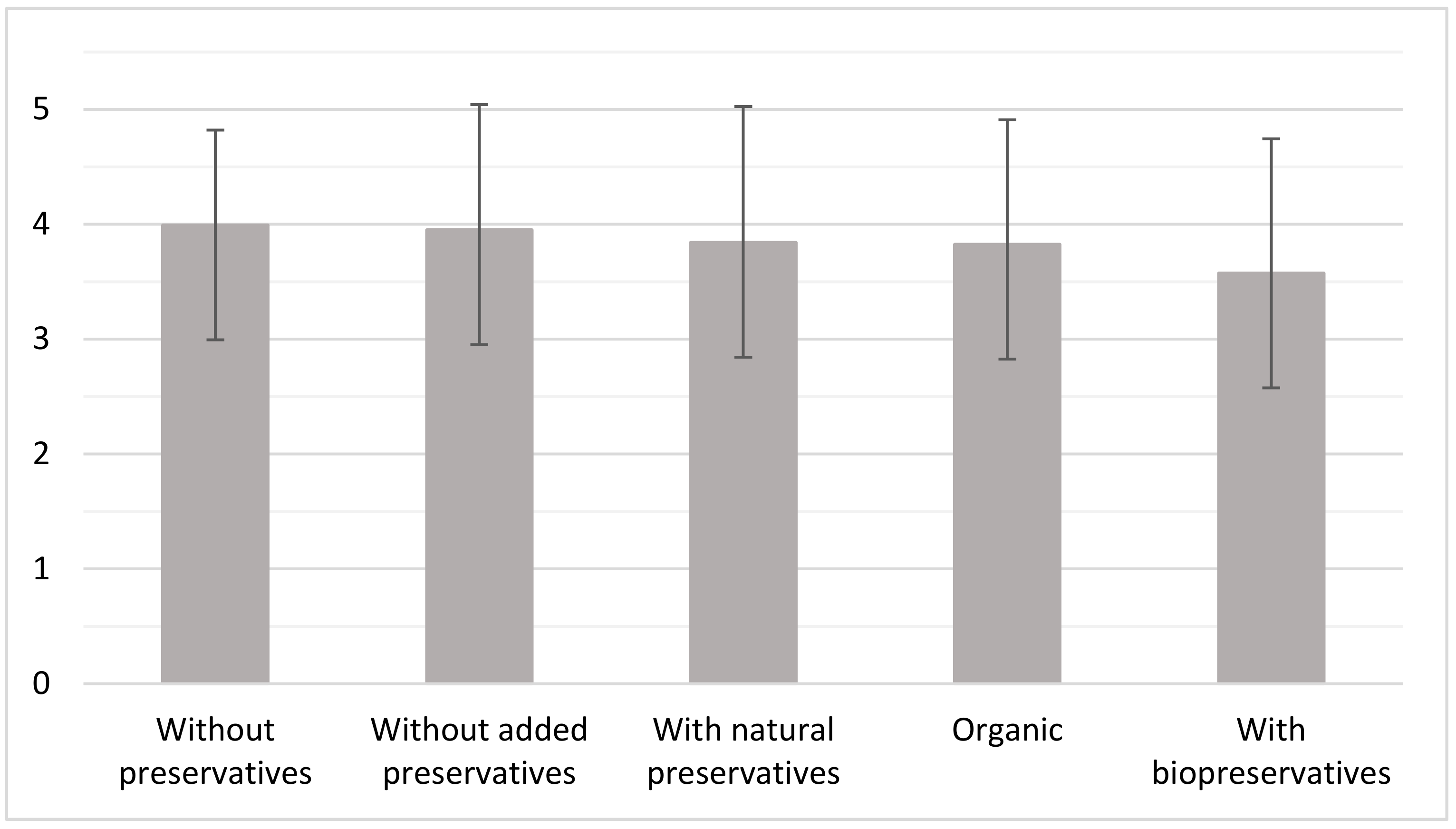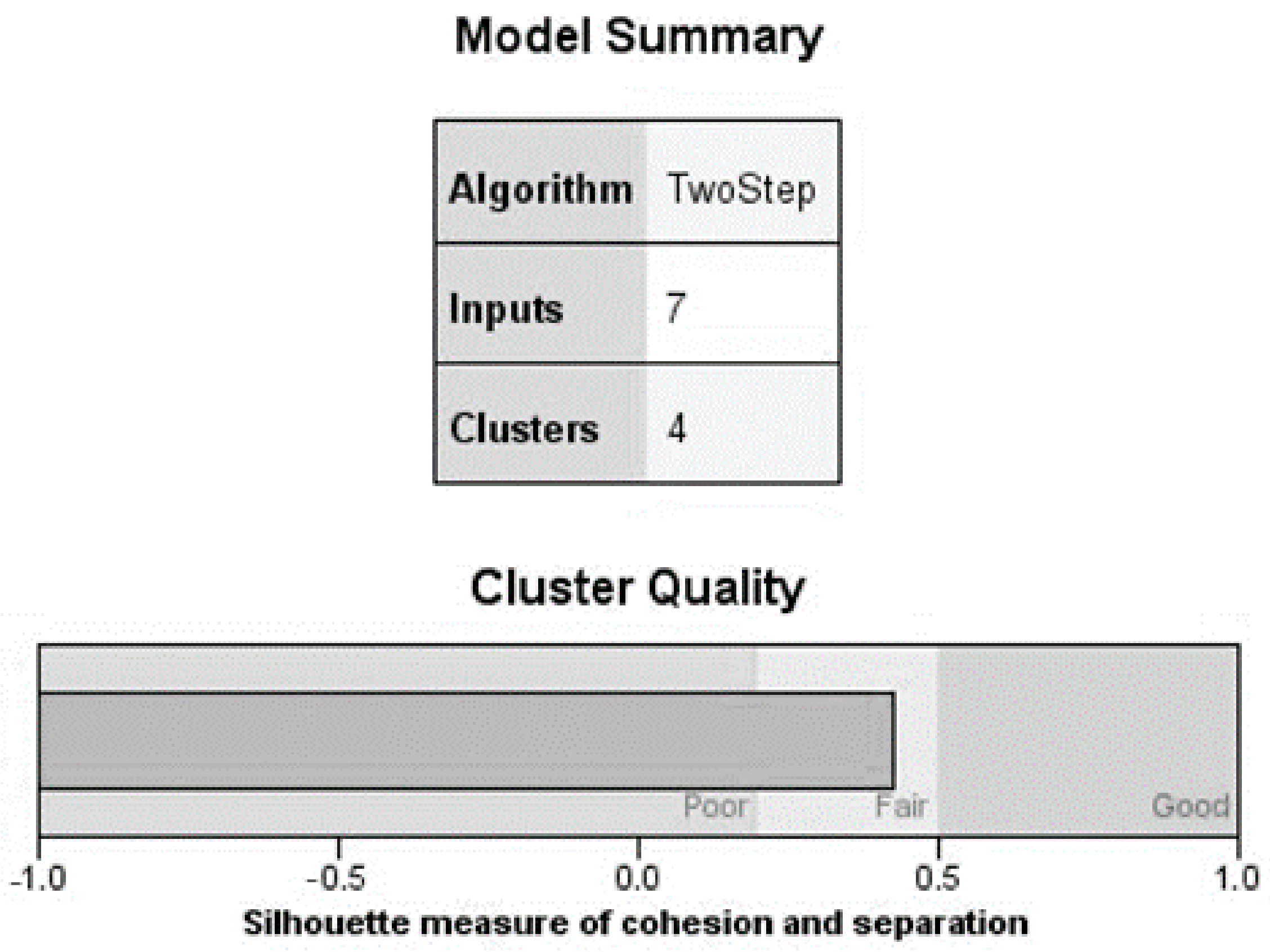Factors Influencing Consumers’ Attitude Towards Biopreservatives
Abstract
1. Introduction
2. Materials and Methods
3. Results and Discussion
4. Conclusions
Author Contributions
Funding
Conflicts of Interest
References
- Regulation (EC) No. 1333/2008 of the European Parliament and of the Council of 16 December 2008 on Food Additives. Available online: https://eur-lex.europa.eu/legal-content/IT/TXT/HTML/?uri=CELEX:32008R1333&from=EN (accessed on 5 May 2020).
- Additives in Dairy Foods; Consumer Perceptions of Additives in Dairy Products. In Encyclopedia of Dairy Sciences, 2nd ed.; Academic Press: Cambridge, MA, USA, 2011. [CrossRef]
- Arbindra, R.; Stanley, M.; Fletcher, K.H.; McWatters, S.; Misra, K.; Deodhar, E. Perception of food safety and change in food consumption habits: A consumer analysis. Int. J. Consum. 2001, 25, 43–52. [Google Scholar] [CrossRef]
- Shim, S.M.; Seo, S.H.; Lee, Y.; Moon, G.I.; Kim, M.S.; Park, J.H. Consumers’ knowledge and safety perceptions of food additives: Evaluation on the effectiveness of transmitting information on preservatives. Food Control 2011, 22, 1054–1060. [Google Scholar] [CrossRef]
- Devcich, D.A.; Pedersen, I.K.; Petrie, K.J. You eat what you are: Modern health worries and the acceptance of natural and synthetic additives in functional foods. Appetite 2007, 48, 333–337. [Google Scholar] [CrossRef] [PubMed]
- Carocho, M.; Barreiro, M.F.; Morales, P.; Ferreira, I.C.F.R. Adding molecules to Food, pros and cons: A review of synthetic and natural food additives. Compr. Rev. Food Sci. Food Saf. 2014, 13, 377–399. [Google Scholar] [CrossRef]
- Bearth, A.; Cousin, M.; Siegrist, M. The consumer’s perception of artificial food additives: Influences on acceptance, risk and benefit perceptions. Food Qual. Prefer. 2014, 38, 14–23. [Google Scholar] [CrossRef]
- Carocho, M.; Morales, P.; Ferreira, I.C. Natural food additives: Quo vadis? Trends Food Sci. Technol. 2015, 45, 284–295. [Google Scholar] [CrossRef]
- Pellegrini, M.; Ricci, A.; Serio, A.; Chaves López, C.; Mazzarrino, G.; D’Amato, S.; Lo Sterzo, C.; Paparella, A. Characterization of essential oils obtained from Abruzzo autochthonous plants: Antioxidant and antimicrobial activities assessment for food application. Foods 2018, 7, 19. [Google Scholar] [CrossRef]
- Perito, M.A.; Di Fonzo, A.; Sansone, M.; Russo, C. Consumer acceptance of food obtained from olive by-products. Brit. Food J. 2019, 122, 212–226. [Google Scholar] [CrossRef]
- Coderoni, S.; Perito, M.A. Sustainable consumption in the circular economy. An analysis of consumers’ purchase intentions for waste-to-value food. J. Clean. Prod. 2020, 252, 119870. [Google Scholar] [CrossRef]
- European Food Safety Authority (EFSA). Use of rosemary extracts as a food additive-Scientific Opinion of the Panel on Food Additives, Flavourings, Processing Aids and Materials in Contact with Food. EFSA J. 2008, 6, 1–29. [Google Scholar] [CrossRef]
- Lockie, S.; Lyons, K.; Lawrence, G.; Grice, J. Choosing organics: A path analysis of factors underlying the selection of organic food among Australian consumers. Appetite 2004, 43, 135–146. [Google Scholar] [CrossRef] [PubMed]
- Rozin, P. The meaning of ‘‘natural”: Process more important than content. Psychol. Sci. 2005, 16, 652–658. [Google Scholar] [CrossRef] [PubMed]
- Siipi, H. Is natural food healthy? J. Agric. Environ. Ethics 2013, 26, 797–812. [Google Scholar] [CrossRef]
- Palmieri, N.; Perito, M.A. Consumers’ willingness to consume sustainable and local wine in Italy. Ital. J. Food Sci. 2020, 32, 222–233. [Google Scholar] [CrossRef]
- Janssen, M. Determinants of organic food purchases: Evidence from household panel data. Food Qual. Prefer. 2018, 68, 19–28. [Google Scholar] [CrossRef]
- Defrancesco, E.; Perito, M.A.; Bozzolan, I.; Cei, L.; Stefani, G. Testing consumers’ preferences for environmental attributes of pasta. Insights from an ABR approach. Sustainability 2017, 9, 1701. [Google Scholar] [CrossRef]
- Willer, H.; Lernoud, J. The World of Organic Agriculture. Statistics and Emerging Trends 2017; Research Institute of Organic Agriculture (FiBL), Frick, and IFOAM—Organics International: Bonn, Germany, 2017. [Google Scholar]
- Jung, Y.J.; Padmanabahn, A.; Hong, J.H.; Lim, J.; Kim, K.O. Consumer freshness perception of spinach samples exposed to different storage conditions. Postharvest Biol. Technol. 2012, 73, 115–121. [Google Scholar] [CrossRef]
- Bertazzoli, A.; Buccioli, N.; Nocella, G. Consumers perception and evaluation of fresh cut buying attributes: A survey on the Italian market. J. Food Prod. Market 2005, 11, 35–55. [Google Scholar] [CrossRef]
- D’Amato, S.; Serio, A.; Chaves López, C.; Paparella, A. Hydrosols: Biological activity and potential as antimicrobials for food applications. Food Control 2018, 86, 126–137. [Google Scholar] [CrossRef]
- Boutouis, M.Z.; Hammoudi, A.; Benhassine, W.; Perito, M.A. Uncertainty of food contamination origin and liability rules: Implications for bargaining power. Agribusiness 2018, 34, 77–92. [Google Scholar] [CrossRef]
- Rossi, C.; Chaves López, C.; Smole Mozina, S.; Di Mattia, C.; Scuota, S.; Luzzi, I.; Jenic, T.; Paparella, A.; Serio, A. Salmonella enterica adhesion: Effect of Cinnamomum zeylanicum essential oil on lettuce. LWT 2019, 111, 16–22. [Google Scholar] [CrossRef]
- Mazzarrino, G.; Paparella, A.; Chaves López, C.; Faberi, A.; Sergi, M.; Sigismondi, C.; Compagnone, D.; Serio, A. Salmonella enterica and Listeria monocytogenes inactivation dynamics after treatment with selected essential oils. Food Control 2015, 50, 794–803. [Google Scholar] [CrossRef]
- Grande-Tovar, C.D.; Serio, A.; Delgado_Ospina, J.; Paparella, A.; Rossi, C.; Chaves López, C. Chitosan films incorporated with Thymus capitatus essential oil: Mechanical properties and antimicrobial activity against degradative bacterial species isolated from tuna (Thunnus sp.) and swordfish (Xiphias gladius). J. Food Sci. Technol. 2018, 55, 4256–4265. [Google Scholar] [CrossRef] [PubMed]
- Hyldgaard, M.; Mygind, T.; Meyer, R.L. Essential oils in food preservation: Mode of action, synergies, and interactions with food matrix components. Front. Microbiol. 2012, 3, 12. [Google Scholar] [CrossRef]
- Nait Mohand, N.; Hammoudi, A.; Radjef, M.S.; Hamza, O.; Perito, M.A. How do food safety regulations influence market price? A theoretical analysis. Brit. Food J. 2017, 119, 1687–1704. [Google Scholar] [CrossRef]
- Regulation (EC) No 1334/2008 of the European Parliament and of the Council of 16 December 2008 on Flavourings and Certain Food Ingredients with Flavouring Properties for Use in and on Foods and Amending Council Regulation (EEC) No 1601/91, Regulations (EC) No 2232/96 and (EC) No 110/2008 and Directive 2000/13/EC. Available online: https://eur-lex.europa.eu/legal-content/EN/ALL/?uri=CELEX%3A32008R1334 (accessed on 5 May 2020).
- Regulation (EU) No 1169/2011 of the European Parliament and of the Council of 25 October 2011 on the Provision of Food Information to Consumers. Available online: https://eur-lex.europa.eu/legal-content/EN/TXT/PDF/?uri=CELEX:32011R1169 (accessed on 5 May 2020).
- Van Boxstael, S.; Devlieghere, F.; Berkvens, D.; Vermeulen, A.; Uyttendaele, M. Understanding and attitude regarding the shelf life labels and dates on pre-packed food products by Belgian consumers. Food Control 2014, 37, 85–92. [Google Scholar] [CrossRef]
- Newsome, R.; Balestrini, C.G.; Baum, M.D.; Corby, J.; Fisher, W.; Goodburn, K.; Labuza, T.P.; Prince, G.; Thesmar, H.S.; Yiannas, F. Applications and perceptions of date labeling of food. Compr. Rev. Food Sci. Food Saf. 2014, 13, 745–769. [Google Scholar] [CrossRef]
- Stranieri, S.; Baldi, L. Shelf life date extension of fresh-cut salad: A consumer perspective. J. Food Prod. Mark. 2017, 23, 939–954. [Google Scholar] [CrossRef]
- Vidal, L.; Ares, G.; Giménez, A. Projective techniques to uncover consumer perception: Application of three methodologies to ready-to-eat salads. Food Qual. Prefer. 2013, 28, 1–7. [Google Scholar] [CrossRef]
- Dinnella, C.; Torri, L.; Caporale, G.; Monteleone, E. An exploratory study of sensory attributes and consumer traits underlying liking for and perceptions of freshness for ready to eat mixed salad leaves in Italy. Food Res. Int. 2014, 59, 108–116. [Google Scholar] [CrossRef]
- García-Díez, J.; Alheiro, J.; Pinto, A.L.; Soares, L.; Falco, V.; Fraqueza, M.J.; Patarata, L. The Impact of essential oils on consumer acceptance of Chouriço de vinho–a dry-cured sausage made from wine-marinated meat–assessed by the Hedonic Scale, JAR intensity scale and consumers’ “Will to Consume and Purchase”. J. Food Process Pres. 2017, 41, e13056. [Google Scholar] [CrossRef]
- Van Gunst, A.; Roodenburg, A.J. Consumer Distrust about E-numbers: A Qualitative Study among Food Experts. Foods 2019, 8, 178. [Google Scholar] [CrossRef] [PubMed]
- Albertsen, L.; Wiedmann, K.P.; Schmidt, S. The Impact of Innovation-related Perception on Consumer Acceptance of Food Innovations-Development of an Integrated Framework of the Consumer Acceptance Process. Food Qual. Prefer. 2020, 84, 103958. [Google Scholar] [CrossRef]
- Chiodo, E.; Casolani, N.; Fantini, A. Regulatory policies and consumers quality perception in the wine sector. Enometrica 2011, 4, 39–57. [Google Scholar]
- Casolani, N.; Greehy, G.M.; Fantini, A.; Chiodo, E.; McCarthy, M.B. Consumer perceptions of nanotechnology applications in Italian wine. Ital. J. Food Sci. 2015, 27, 93–107. [Google Scholar] [CrossRef]
- Palmieri, N.; Perito, M.A.; Macrì, M.C.; Lupi, C. Exploring consumers’ willingness to eat insects in Italy. Brit. Food J. 2019, 121, 2937–2950. [Google Scholar] [CrossRef]
- Palmieri, N.; Perito, M.A.; Lupi, C. Consumer acceptance of cultured meat: Some hints from Italy. Brit. Food J. 2020. [Google Scholar] [CrossRef]
- Dickson-Spillmann, M.; Siegrist, M.; Keller, C. Attitudes toward chemicals are associated with preference for natural food. Food Qual. Prefer. 2011, 22, 149–156. [Google Scholar] [CrossRef]
- Palmieri, N.; Forleo, M.B. The potential of edible seaweed within the western diet. A segmentation of Italian consumers. Int. J. Gastron. Food Sci. 2020, 20, 100202. [Google Scholar] [CrossRef]
- Kaiser, H.F. An index of factorial simplicity. Psychometrika 1974, 39, 31–36. [Google Scholar] [CrossRef]
- Hair, J.F.; Black, W.C.; Babin, B.J.; Anderson, R.E.; Tatham, R.L. Multivariate Data Analysis, 5th ed.; Prentice Hall: Upper Saddle River, NJ, USA, 1998; pp. 207–219. [Google Scholar]
- Rousseeuw, P.J. Silhouettes: A Graphical Aid to the Interpretation and Validation of Cluster Analysis. J. Comput. Appl. Math. 1998, 20, 53–65. [Google Scholar] [CrossRef]
- Song, H.; Schwarz, N. If it’s difficult to pronounce, it must be risky: Fluency, familiarity, and risk perception. Psychol. Sci. 2009, 20, 135–138. [Google Scholar] [CrossRef] [PubMed]
- Kaptan, B.; Kayısoglu, S. Consumers’ attitude towards food additives. Am. J. Food Sci. Nutr. Res. 2015, 2, 21–25. [Google Scholar]
- Kim, E.J.; Na, H.J.; Kim, Y.N. Awareness on food additives and purchase of processed foods containing food additives in middle school students. Korean J. Hum. Ecol. 2007, 16, 205–218. [Google Scholar] [CrossRef]
- Aoki, K.; Shen, J.; Saijo, T. Consumer reaction to information on food additives: Evidence from an eating experiment and a field survey. Econ. Behav. Organ 2010, 73, 433–438. [Google Scholar] [CrossRef]
- Grunert, K.G. Food quality and safety: Consumer perception and demand. Eur. Rev. Agric. Econ. 2005, 32, 369–391. [Google Scholar] [CrossRef]
- European Commission. Special Eurobarometer: Health and Food, 2006. Retrieved 19 September 2008. Available online: http://ec.europa.eu/health/ph_publication/eb_food_en.pdf (accessed on 8 February 2020).
- Russo, C.; Simeone, M.; Perito, M.A. Educated Millennials and Credence Attributes of Food Products with Genetically Modified Organisms: Knowledge, Trust and Social Media. Sustainability 2020, 12, 8534. [Google Scholar] [CrossRef]
- Do Paco, A.; Raposo, M. “Green” segmentation: An application to the Portuguese consumer market. Mark. Intell. Plann. 2009, 27, 364–379. [Google Scholar] [CrossRef]
- Perito, M.A.; Coderoni, S.; Russo, C. Consumer Attitudes towards Local and Organic Food with Upcycled Ingredients: An Italian Case Study for Olive Leaves. Foods 2020, 9, 1325. [Google Scholar] [CrossRef]



| Kaiser-Meyer-Olkin Measure of Sampling Adequacy | 0.703 | |
| Bartlett’s Test of Sphericity | Approx. Chi-Square | 2638.368 |
| Df | 190 | |
| Sig. | 0.000 | |
| Variables | Components | |||||||
|---|---|---|---|---|---|---|---|---|
| CP1 | CP2 | CP3 | CP4 | CP5 | CP6 | CP7 | CP8 | |
| Sensitivity to label claims | ||||||||
| Influence of the label: “with natural preservatives” | 0.780 | 0.235 | 0.165 | −0.103 | ||||
| Influence of the label: “with biopreservatives” | 0.766 | 0.246 | 0.234 | −0.108 | ||||
| Influence of the label “Organic product” | 0.512 | 0.640 | 0.148 | |||||
| Level of attention to Ingredients | 0.297 | 0.739 | 0.180 | −0.142 | ||||
| Level of attention to the Product origin | 0.143 | 0.570 | 0.314 | 0.147 | 0.207 | 0.270 | 0.110 | |
| Level of attention to Nutritional Information | 0.415 | 0.545 | 0.148 | 0.127 | ||||
| Level of attention to Organic certification | 0.378 | 0.300 | 0.704 | |||||
| Level of attention to Brand | 0.118 | 0.104 | 0.755 | |||||
| Level of attention to Price | 0.140 | 0.126 | 0.186 | 0.722 | ||||
| Consumers behaviour | ||||||||
| Frequency of reading label | 0.819 | 0.201 | 0.116 | |||||
| Frequency of organic food consumption | 0.190 | 0.803 | 0.169 | |||||
| Unwillingness to pay more for a cheese treated with natural preservatives | 0.914 | |||||||
| Unwillingness to pay more for a salad treated with natural preservatives | 0.106 | 0.913 | 0.103 | |||||
| Willingness to pay more for food treated with natural preservatives | 0.909 | 0.116 | ||||||
| Willingness to pay more for food treated with natural preservatives in substitution of synthetic ones | 0.115 | 0.165 | 0.789 | 0.269 | ||||
| Willingness to pay more for food treated with natural preservatives if the shelf life of the product increase | 0.842 | 0.110 | ||||||
| Preference for a ready-to-eat fruit salad treated with biopreservatives, expiring at 5 days respect the same product without preservatives expiring at 3 days | 0.127 | 0.225 | 0.650 | 0.213 | ||||
| Personal Characteristics | ||||||||
| Age | 0.154 | 0.115 | 0.460 | 0.197 | 0.438 | |||
| Knowledge about biopreservatives | 0.131 | 0.135 | 0.679 | |||||
| Gender | 0.450 | 0.122 | 0.219 | 0.614 | ||||
| Clusters | 1 (Enthusiastic) | 2 (Rational) | 3 (Disinterested) | 4 (Conscious and Attentive) | Total | |||||
|---|---|---|---|---|---|---|---|---|---|---|
| Personal characteristics | ||||||||||
| Gender (0 = female, 1= male) | 0.45 | (0.501) | 0.40 | (0.491) | 0.51 | (0.505) | 0.37 | (0.488) | 0.42 | (0.494) |
| Age | 38.05 | (10.467) | 36.75 | (11.515) | 37.24 | (12.239) | 35.98 | (13.309) | 36.923 | (11.641) |
| Knowledge about biopreservatives * | 2.35 | (0.873) | 2.47 | (0.858) | 2.39 | (0.918) | 2.56 | (1.038) | 2.46 | (0.890) |
| Sensitivity to label claims | ||||||||||
| Level of attention to Nutritional Information * | 3.94 | (1.173) | 3.72 | (1.183) | 3.43 | (1.118) | 3.68 | (1.105) | 3.72 | (1.169) |
| Level of attention to Brand * | 2.64 | (1.183) | 2.86 | (1.120) | 2.55 | (1.101) | 2.86 | (1.025) | 2.79 | (1.120) |
| Level of attention to Organic certification * | 3.63 | (1.354) | 3.23 | (1.249) | 2.65 | (1.230) | 2.81 | (1.238) | 3.18 | (1.292) |
| Level of attention to Product origin * | 4.06 | (1.205) | 4.00 | (1.091) | 3.31 | (1.516) | 3.53 | (1.056) | 3.88 | (1.182) |
| Level of attention to Price * | 3.81 | (1.092) | 3.59 | (1.080) | 3.96 | (1.183) | 4.03 | (0.909) | 3.72 | (1.084) |
| Level of attention to Ingredients * | 4.24 | (1.046) | 4.16 | (1.055) | 3.86 | (1.281) | 3.85 | (1.096) | 4.10 | (1.090) |
| Consumers behavior | ||||||||||
| Frequency of reading label * | 3.05 | (1.146) | 2.94 | (1.054) | 2.75 | (1.214) | 2.81 | (1.025) | 2.92 | (1.084) |
| Frequency of organic food consumption * | 1.76 | (0.945) | 1.72 | (0.940) | 1.37 | (0.958) | 1.49 | (0.858) | 1.66 | (0.939) |
Publisher’s Note: MDPI stays neutral with regard to jurisdictional claims in published maps and institutional affiliations. |
© 2020 by the authors. Licensee MDPI, Basel, Switzerland. This article is an open access article distributed under the terms and conditions of the Creative Commons Attribution (CC BY) license (http://creativecommons.org/licenses/by/4.0/).
Share and Cite
Perito, M.A.; Chiodo, E.; Serio, A.; Paparella, A.; Fantini, A. Factors Influencing Consumers’ Attitude Towards Biopreservatives. Sustainability 2020, 12, 10338. https://doi.org/10.3390/su122410338
Perito MA, Chiodo E, Serio A, Paparella A, Fantini A. Factors Influencing Consumers’ Attitude Towards Biopreservatives. Sustainability. 2020; 12(24):10338. https://doi.org/10.3390/su122410338
Chicago/Turabian StylePerito, Maria Angela, Emilio Chiodo, Annalisa Serio, Antonello Paparella, and Andrea Fantini. 2020. "Factors Influencing Consumers’ Attitude Towards Biopreservatives" Sustainability 12, no. 24: 10338. https://doi.org/10.3390/su122410338
APA StylePerito, M. A., Chiodo, E., Serio, A., Paparella, A., & Fantini, A. (2020). Factors Influencing Consumers’ Attitude Towards Biopreservatives. Sustainability, 12(24), 10338. https://doi.org/10.3390/su122410338









